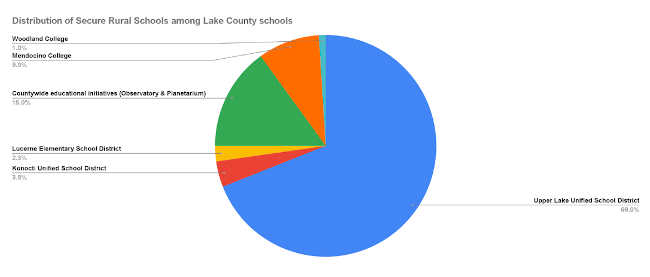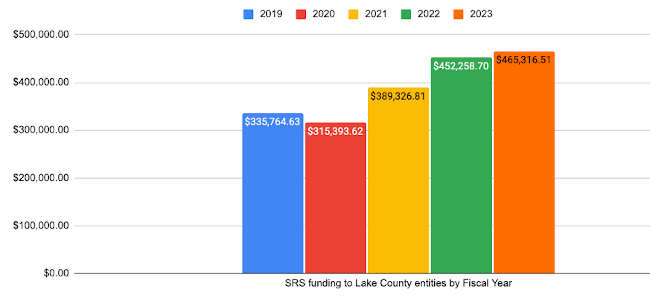The Secure Rural Schools program helps fund public services like schools and roads in counties with large tracts of federal land. Last year, it brought more than $33 million to rural communities across California.
However, it expired in June and was not reauthorized, as CalMatters has reported. Although it was passed unanimously in the Senate in the fall, it was not included in the temporary budget passed in December and the congressional budget passed in March.
“We will stop receiving funding as of April of this year,” said Lake County Officer of Education Director Brock Falkenberg during the Board of Supervisors meeting last Tuesday.
Without renewal, schools may face layoffs and program cuts, while infrastructure projects risk stalling.
“The Secure Rural Schools Program has been instrumental in providing stable funding for our schools and infrastructure,” the supervisors’ letter to Thompson said.
“Rural roads that ensure access to schools, ingress and egress in the event of wildfire emergencies, and promote rural economic opportunity are maintained using this crucial funding source. Any reduction in either education or roads funding would be detrimental to Lake County; public safety, long-term economic vibrancy, and access to critical services will all be affected,” the letter said.
Now, over 50 congressmembers across states and partylines, including Thompson, have cosponsored the Secure Rural Schools Reauthorization Act 2025, seeking renewal of this critical funding.
“I know we're speaking to the choir with our congressman, but appreciate what he's doing and anything we can do to back him up and let him know that we can help his voice become louder,” District 2 Supervisor Bruno Sabatier said before the board voted unanimously in favor of sending the letter.
Rural California — including Lake County — is taking the hit
The Secure Rural Schools funding is distributed based on the acreage of federal forest land in each eligible county. For example, the counties with largest federal land include Siskiyou which received $4.3 million in the past year; Trinity, $3.5 million; and Plumas, $3.4 million.
Lake County, with 258,602 acres of the Mendocino National Forest, received $465,316.51.
Affected rural communities in California have been raising concerns over the loss of the funding — and Lake County is no exception.
“Our county is not being hit as hard as other counties in Northern California that have bigger areas, larger tracks of forest lands, but it is significant,” said District 5 Supervisor Jessica Pyska. “It’s significant enough for us to really have concerns and see the impact to our schools.”
The funding is usually split into half between the county and the schools, said Falkenberg, who went on to explain the impact of the funding cuts on Lake County schools.
“If we were not to receive this funding, ultimately we would have to answer the question of how do we continue to fund the observatory, the planetarium, and the funds that are passed through to the school districts, which would equal about two and a half full time equivalent teaching positions,” he said, adding that the Upper Lake Unified School District will take the hardest hit as it has the largest acreage of federal land.
Falkenberg said the schools received roughly $200,000 to $250,000 each year over the last few years. “The bulk of that money goes to the Upper Lake Unified School District,” he later told Lake County News. “So for them, it's significant. It might not be huge, but it's significant.”

On the county’s road projects, the Secure Rural Schools funding “would be used for school area signage and for pavement markings and speed studies,” said Chief Deputy County Administrative Officer Matthew Rothstein at the meeting, drawing from notes given by Public Works Director Glen March who was absent.
The project is meant to mitigate concerns over traffic patterns around schools and to “encourage people to slow down in the areas of our schools,” Rothsten said.
“The infrastructure piece from the county is to make our schools safer. So that's why I thought it was urgent to bring this to us,” Supervisor Pyska said. “This funding cut directly impacts us in Lake County.”
“This is a bipartisan issue,” said Sabatier, recalling a recent meeting with Modoc County officials at Washington D.C.
“I sat down in the White House with Modoc County, who is very red, very conservative and they were very concerned about their losses as well,” said Sabatier. “So I think this goes across the board, that people are not wanting to see this go away.”
“Federal funding is absolutely critical for our local schools in Lake County. This funding ensures Lake County teachers and students have the resources they need to succeed and helps fund repairs for our local roads,” Thompson said in response to Lake County News’ request for comment.
“Any cuts to the Secure Rural Schools program, or to any other federal education funding, would hurt our kids. I will continue to work to renew this program and to protect all of the federal programs Lake County residents rely on every day,” he added.
The history of Secure Rural Schools funding in Lake County
For more than a century, the federal government has been subsidizing counties with large federal forest land.
Since 1908, the Forest Service Act has been enacted to set a portion — 25% of the revenue generated from activities like timber production and special permit use — to the local governments as compensation for not collecting tax on the federal land.
After the agency’s revenue declined for decades, in 2000, Congress passed the Secure Rural Schools and Community Self Determination Act to “help stabilize the funds available to rural counties,” according to the Forest Service under the U.S. Department of Agriculture.
During the board meeting, Falkenberg explained that the timber sale declined because the Endangered Species Act had started to “limit or make it much more difficult to harvest timber on national forest land.”
The Secure Rural Schools Act, then, was established as “a temporary, short term funding model,” while Congress tried to reconcile the tension between the two acts, Falkenberg said. “They have never been able to come to a consensus on how to manage that.”
With the new source of funding, counties could choose one of the two funding channels: either through the 1908 Act that pays 25% of timber revenues, or through Secure Rural Schools.
“The local county can elect to receive the greater of the two,” Falkenberg explained over a phone call with Lake County News.
Congress periodically allows counties to choose between the two payment types, with the last selection in 2013 and the choice locked.
In an approved 2012 resolution provided by Rothstein, Lake County opted for Secure Rural Schools.
“So for the last 25 years, counties and schools have continued to receive the secure rural schools funding in lieu of the 25% payment passed through with the exception of 2015/16—there was not a reauthorization,” Falkenberg said during the meeting. “So that particular year … we went from roughly half a million dollars to $14,000.”
The Secure Rural School funding allocates dollars under three titles: Title I for roads and schools, Title II for projects on federal lands and TITLE III for county projects. While Title II funds are retained by Forest Service, Title I and II go to local entities.
The chart below shows the total funding distributed to Lake County entities in the past five years under Title I and III.
“Distribution for the payments is off by a year,” explained Lauren Ott of Congressman Thompson’s office. So the Fiscal Year 2023 figures reflect money distributed in Fiscal Year 2024, she added.

Falkenberg is concerned that Lake County will receive even less than 2015/16 if Secure Rural Schools does not get reauthorized.
“If we revert back to the 25% funding rule, we're going to see that number drop to, I don't know, less than 10% or less than $10,000,” he told Lake County News.
Email staff reporter Lingzi Chen at

 How to resolve AdBlock issue?
How to resolve AdBlock issue? 



